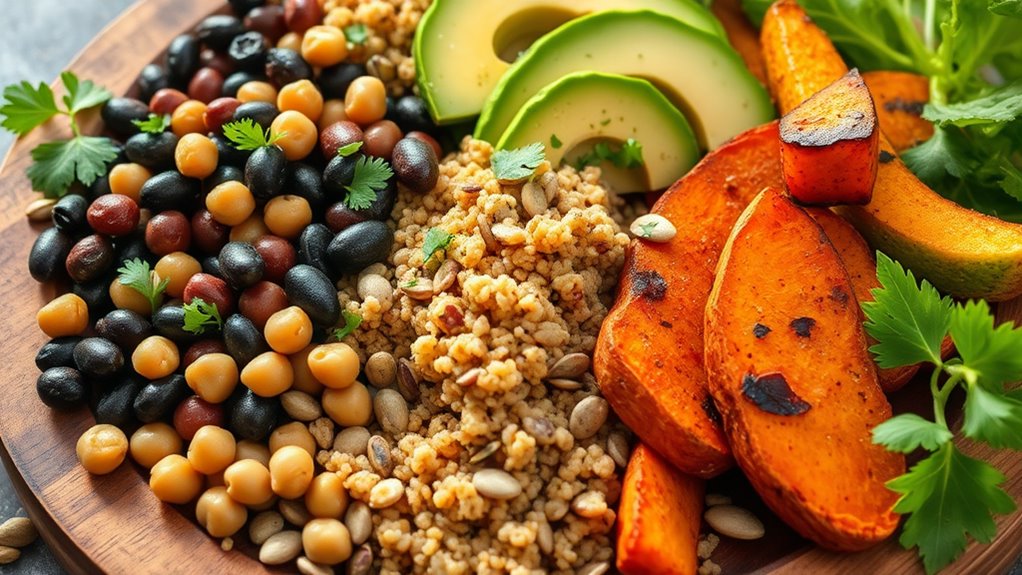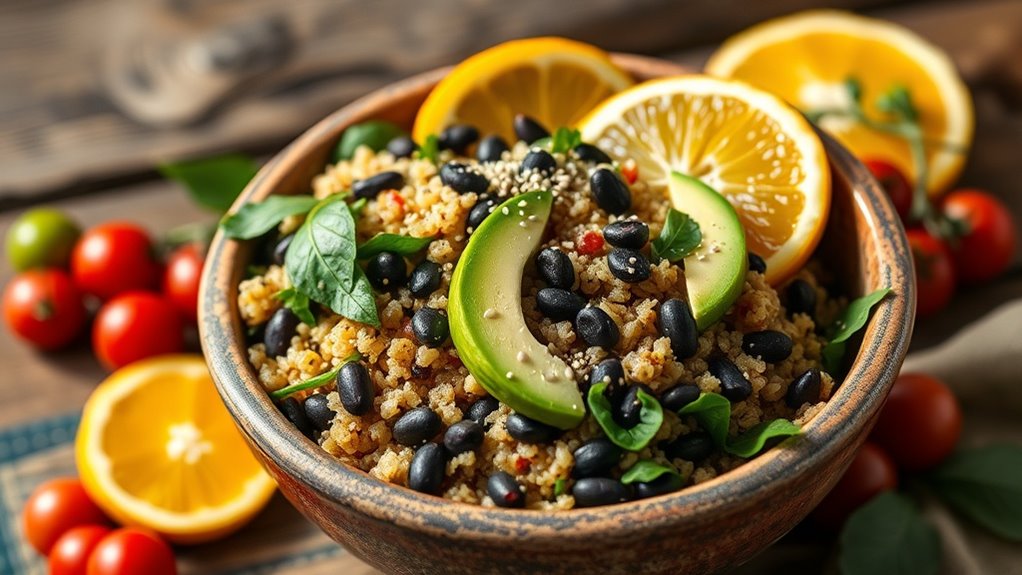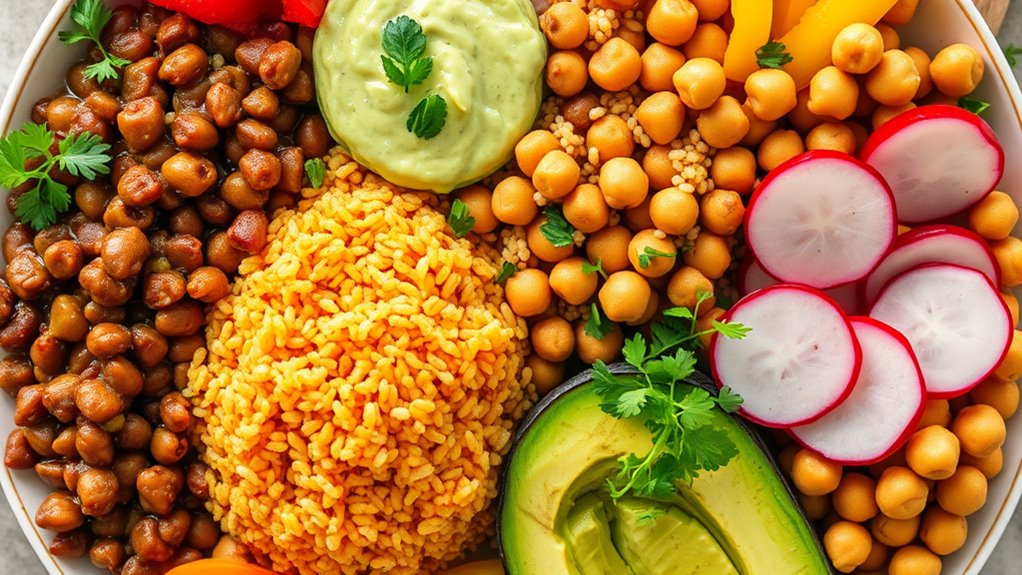Plant-Based Proteins That Are Better Than Meat!
Did you know that plant-based proteins can provide up to 30% more nutrients per calorie than meat? This striking fact highlights the significant advantages of incorporating these foods into your diet. From improving your health to minimizing your environmental footprint, there’s much to uncover about the rich, diverse sources of plant proteins. So, what are the top choices worth considering, and how can they enhance your meals? Let’s explore.
Key Takeaways
- Plant-based proteins offer essential nutrients without the saturated fats found in meat, promoting overall health and well-being.
- Foods like lentils, quinoa, and chickpeas provide high protein and fiber, supporting digestion and satiety.
- Plant proteins have environmental advantages, including lower greenhouse gas emissions and reduced resource consumption compared to meat production.
- Combining various plant sources ensures a full amino acid profile, comparable in quality to that of animal proteins.
- Transitioning to plant-based proteins can improve heart health and aid in weight management, promoting a sustainable lifestyle.
Nutritional Benefits of Plant-Based Proteins
Plant-based proteins offer a wealth of nutritional benefits that can enhance your overall health. By incorporating meat alternatives into your diet, you’ll gain essential nutrients without the saturated fats often found in animal products.
These proteins provide fiber, which aids digestion and promotes a healthy gut, along with vitamins and minerals crucial for peak function. You’ll also benefit from antioxidants, which can reduce inflammation and lower the risk of chronic diseases.
Plus, plant proteins can help regulate blood sugar levels, making them an excellent choice for maintaining energy and focus throughout the day. Additionally, many plant-based options are rich in essential nutrients that contribute to a balanced diet.
In mastering a plant-based approach, you’re not just making a dietary shift; you’re embracing a holistic path toward higher energy and wellbeing.
Top Plant-Based Protein Sources
When it comes to incorporating plant-based proteins into your meals, a variety of options can satisfy your nutritional needs while being delicious.
Start with lentils; they’re packed with protein and fiber—perfect for soups or salads. Quinoa is another powerhouse; it’s a complete protein that works well in bowls or as a side dish.
Don’t overlook chickpeas; they’re versatile enough for hummus, stews, or roasted snacks. Tofu and tempeh serve as excellent meat substitutes, absorbing flavors beautifully in stir-fries.
Meanwhile, edamame offers a crunchy side rich in protein. Finally, consider nuts and seeds—great for snacking or as toppings. Additionally, these plant-based proteins also provide additional health benefits such as improved digestion and heart health.
Environmental Advantages Over Meat
Switching to plant-based proteins not only benefits your health but also offers considerable environmental advantages over meat. By making this shift, you’re contributing to a more sustainable future.
Consider these key benefits:
-
Lower Greenhouse Gas Emissions: Plant-based diets produce fewer emissions, helping mitigate climate change.
-
Reduced Land Use: Growing crops for direct human consumption requires less land than raising animals for meat, preserving natural habitats.
-
Conserved Water Resources: Plant proteins demand considerably less water compared to meat production, essential in addressing water scarcity issues.
Furthermore, incorporating unexpected plant-based protein sources can enhance the nutritional value of your meals.
Choosing plant-based proteins isn’t just a personal health decision; it’s an impactful choice for the planet.
Culinary Uses of Plant-Based Proteins
Now that you understand the environmental benefits of plant-based proteins, let’s explore their culinary potential.
These versatile ingredients can transform your meals when you master flavor pairing techniques and different cooking methods. One such innovative option is surprising plant-based proteins, which can elevate your dishes to new heights. You’ll find endless possibilities to create delicious, satisfying dishes.
Versatile Ingredient Options
As you explore culinary uses for plant-based proteins, you’ll discover an exciting world of versatile ingredient options that can elevate your dishes.
These ingredients not only cater to diverse dietary preferences but also offer unique textures and nutritional benefits.
-
Lentils: Perfect for soups, salads, and veggie burgers, they cook quickly and absorb flavors beautifully.
-
Chickpeas: Enhance your cuisine with hummus, stews, or roasted snacks, providing a hearty boost to meals.
-
Quinoa: This complete protein works wonders as a base for salads, grain bowls, or even breakfast dishes.
Flavor Pairing Techniques
While exploring flavor pairing techniques, you’ll find that combining plant-based proteins with the right ingredients can greatly enhance your culinary creations.
Start by considering complementary flavors—pair lentils with citrus or garlic to elevate their earthiness. For tempeh, think about smoked paprika or maple syrup, which add depth and sweetness.
Don’t shy away from herbs and spices; fresh basil or cilantro can brighten heavier dishes.
Fermented ingredients like miso or nutritional yeast can impart umami, linking proteins like quinoa with robust flavors.
Also, balance textures! Contrast creamy sauces with crispy veggies for a dynamic dish.
Cooking Methods Explored
When you’re exploring cooking methods for plant-based proteins, you’ll quickly discover that each technique can transform your meals in unique ways.
Mastering these methods can elevate your culinary skills and enhance the flavors of your dishes.
-
Grilling: Infuses smoky flavors and creates appealing char marks on tofu or tempeh.
-
Sautéing: Quickly cooks vegetables and legume-based proteins, preserving their texture and nutrients.
-
Roasting: Caramelizes sugars, intensifying the natural flavors of legumes and grains.
Using these techniques allows you to experiment and find combinations that please your palate.
Don’t hesitate to play with temperature and timing; it’s all about achieving that perfect balance.
Immerse yourself in these methods, and you’ll reveal the full potential of plant-based proteins!
Measuring Protein Quality in Plant Foods
When evaluating the quality of plant-based proteins, you’ll want to contemplate several key factors.
The Protein Digestibility Corrected Amino Acid Score (PDCAAS) and Biological Value (BV) can help you compare different sources.
Additionally, looking at the diversity of the amino acid profile will give you a clearer picture of nutritional completeness.
Protein Digestibility Corrected Amino Acid Score
Evaluating protein quality in plant foods hinges on the Protein Digestibility Corrected Amino Acid Score (PDCAAS), a key metric that accounts for both the amino acid profile and the digestibility of the protein consumed.
This score is essential for determining how effectively your body can utilize the protein from plant sources. High PDCAAS values indicate that a protein isn’t only rich in essential amino acids but also easily digestible.
- It ranges from 0 to 1.0, with 1.0 being the highest quality.
- Soy, beans, and peas often score high on this scale.
- PDCAAS helps compare plant proteins to animal proteins, guiding your dietary choices.
Understanding PDCAAS empowers you to select nutrient-dense plant proteins effectively.
Biological Value Comparison
While understanding protein quality in plant foods involves several metrics, the Biological Value (BV) provides a unique perspective on how well your body can utilize the protein consumed.
BV measures the proportion of absorbed protein from your diet that’s incorporated into your body’s proteins. A higher BV indicates a more efficient protein source.
For example, soy protein boasts a competitive BV, often nearing that of animal proteins. This means your body can effectively use the protein from soy for muscle synthesis and other crucial functions.
When selecting plant proteins, aim for those with higher BV values, as they guarantee better utilization. Knowing this metric empowers you to optimize your protein sources for peak performance and overall health.
Amino Acid Profile Diversity
Understanding the diversity of amino acid profiles in plant proteins is essential for evaluating their overall quality.
While some plant sources might lack certain essential amino acids, combining different sources can create a complete protein profile.
Here’s what to evaluate:
-
Essential Amino Acids: Make sure you’re getting all nine essential amino acids your body doesn’t produce.
-
Protein Completeness: Pairing legumes with grains can provide balanced nutrition, exceeding what individual sources offer.
-
Digestibility: Some plant proteins may be less digestible than meat; knowing this helps you choose more efficient sources.
Overcoming Common Misconceptions About Plant Proteins
Many people mistakenly believe that plant-based proteins can’t match the quality or nutritional value of animal proteins, but this misconception can prevent you from fully appreciating the benefits of incorporating more plant-based options into your diet. In reality, many plant proteins provide essential nutrients and offer unique advantages. Not only are many plant proteins nutritious, but they also have a significantly lower environmental impact compared to meat production.
| Plant Protein | Benefits |
|---|---|
| Quinoa | Complete amino acid profile |
| Lentils | High fiber, low fat |
| Chickpeas | Rich in iron and magnesium |
Understanding these benefits reveals that not only can plant proteins satisfy your nutritional needs, but they can also support heart health and weight management. Embracing a variety of sources elevates your diet and well-being. Make the switch, and you’ll discover a new world of nutrition!





